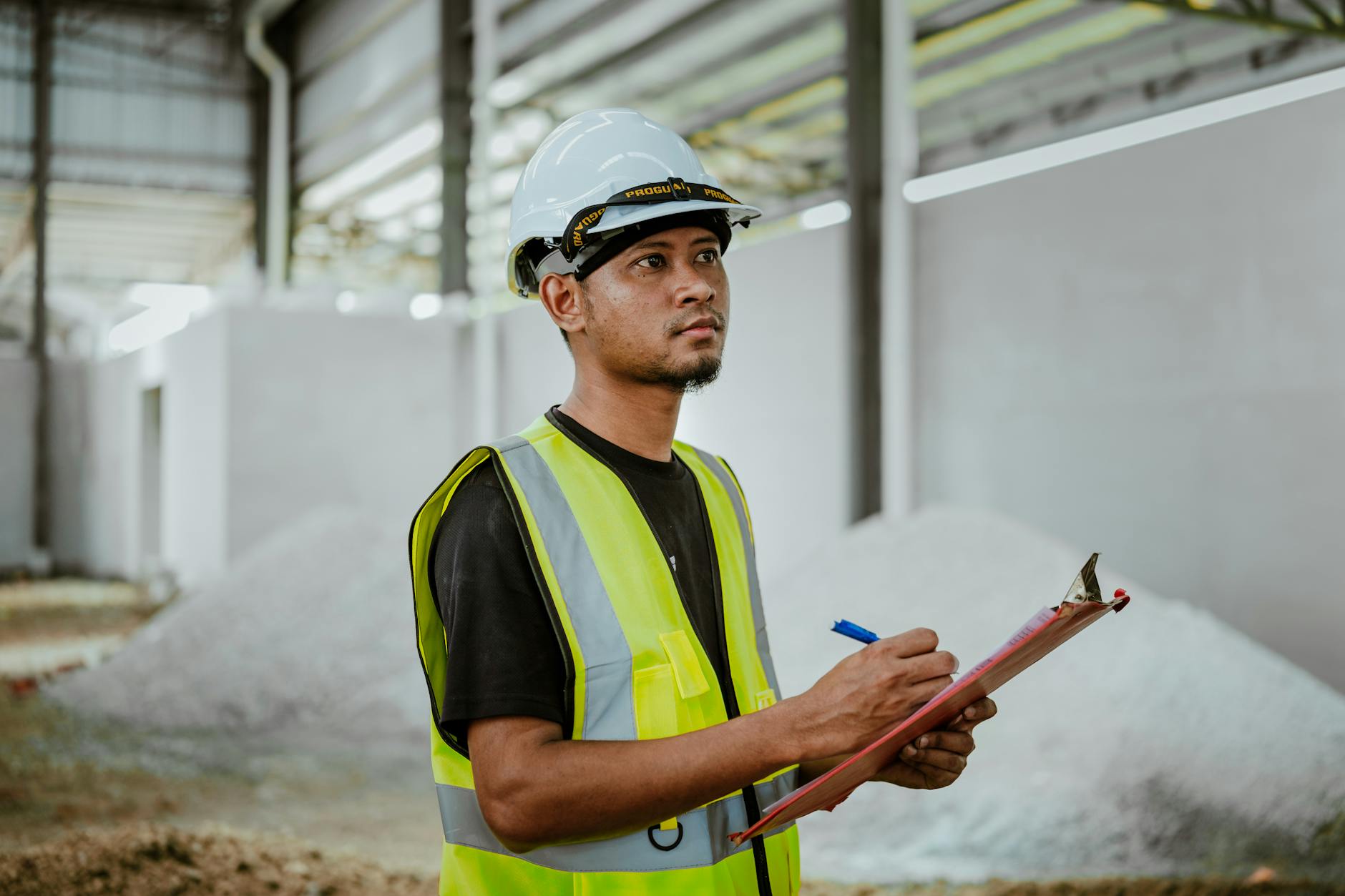
Manufacturing Safety Interview: 50 Questions and Sample Answers
1. What is manufacturing safety?
Answer: Manufacturing safety refers to the practices, procedures, and regulations designed to protect workers from hazards in a manufacturing environment.
2. Why is safety important in manufacturing?
Answer: Safety prevents injuries, equipment damage, and production delays while ensuring compliance with legal regulations.
3. What are the common hazards in manufacturing?
Answer:
- Machine-related injuries
- Chemical exposure
- Slips, trips, and falls
- Electrical hazards
- Fire and explosion risks
4. What is a Safety Data Sheet (SDS)?
Answer: SDS provides critical information on hazardous substances, including handling, storage, and emergency measures.
5. What is Personal Protective Equipment (PPE) in manufacturing?
Answer:
- Eye protection (safety goggles)
- Hearing protection (earplugs, earmuffs)
- Respirators for chemical exposure
- Gloves and safety shoes
6. What is Lockout/Tagout (LOTO)?
Answer: A procedure that isolates energy sources to prevent accidental startup of machinery during maintenance.
7. What are the key elements of machine safety?
Answer:
- Machine guards to prevent contact with moving parts
- Emergency stop buttons
- Regular maintenance checks
8. How do you prevent slips, trips, and falls in manufacturing?
Answer:
- Keep floors dry and clean
- Use anti-slip mats
- Ensure proper housekeeping
9. What are the main fire hazards in manufacturing?
Answer:
- Flammable materials (chemicals, gases)
- Electrical faults
- Welding and cutting operations
10. What is the purpose of a risk assessment in manufacturing?
Answer: To identify hazards, assess risks, and implement control measures to reduce workplace injuries.
11. What is an emergency evacuation plan?
Answer: A structured procedure that ensures safe and quick evacuation during a fire, chemical spill, or other emergencies.
12. How do you ensure electrical safety in manufacturing?
Answer:
- Use insulated tools
- Proper grounding of equipment
- Regular electrical inspections
13. What is the role of a safety officer in manufacturing?
Answer:
- Conduct safety training and audits
- Investigate accidents and near misses
- Ensure regulatory compliance
14. How do you control hazardous chemical exposure?
Answer:
- Use ventilation systems
- Provide proper PPE
- Implement safe storage procedures
15. What is ergonomics, and why is it important?
Answer: Ergonomics ensures workstations are designed to reduce strain and prevent musculoskeletal disorders (MSDs).
16. What is a near miss, and how should it be reported?
Answer: A near miss is an unplanned event that could have caused harm but didn’t. It should be reported immediately for corrective actions.
17. How do you ensure safe lifting techniques in manufacturing?
Answer:
- Bend your knees, not your back
- Keep loads close to the body
- Use mechanical lifting aids
18. What is confined space safety in manufacturing?
Answer: Confined spaces (tanks, pits) may have toxic gases, low oxygen, or engulfment hazards, requiring permits and gas testing.
19. What is the difference between a hazard and a risk?
Answer:
- Hazard: A potential source of harm
- Risk: The likelihood of the hazard causing harm
20. How do you prevent hearing loss in noisy manufacturing environments?
Answer:
- Use earplugs or earmuffs
- Reduce noise levels with engineering controls
- Implement noise exposure monitoring
21. What is a safety audit?
Answer: A systematic evaluation of safety practices to ensure compliance with standards.
22. What is an MSDS, and why is it important?
Answer: A Material Safety Data Sheet (MSDS) provides safety information about hazardous chemicals.
23. How do you prevent fires in manufacturing plants?
Answer:
- Store flammable materials properly
- Use fire extinguishers
- Conduct fire drills regularly
24. What is a permit-to-work system?
Answer: A system that ensures high-risk jobs (hot work, confined space entry) are performed safely with authorization.
25. How do you handle chemical spills?
Answer:
- Evacuate and contain the spill
- Use absorbent materials
- Wear proper PPE
26. What is a safety culture?
Answer: A workplace environment where safety is prioritized and embedded in daily operations.
27. How do you prevent machine entanglement injuries?
Answer:
- Wear tight-fitting clothing
- Avoid jewelry and loose hair
- Ensure machines have proper guards
28. What is Job Safety Analysis (JSA)?
Answer: A structured approach to identify and control hazards in a specific job task.
29. How do you control dust hazards in manufacturing?
Answer:
- Use dust extraction systems
- Provide respiratory protection
30. What is a workplace inspection?
Answer: A process of checking workplace conditions, equipment, and procedures to identify hazards.
31. What is an incident investigation?
Answer: A process to analyze accidents to find root causes and prevent recurrence.
32. How do you prevent forklift accidents?
Answer:
- Train certified operators
- Maintain safe speed limits
- Use warning signals
33. What is process safety management (PSM)?
Answer: A system for managing hazardous chemical processes to prevent accidents.
34. How do you ensure welding safety?
Answer:
- Use fire-resistant blankets
- Provide ventilation for fumes
35. What is a stop work authority (SWA)?
Answer: The right of employees to stop work if they identify unsafe conditions.
36. What are the different types of safety signs?
Answer:
- Warning signs (hazardous materials)
- Mandatory signs (PPE required)
37. How do you prevent musculoskeletal disorders (MSDs)?
Answer:
- Provide adjustable workstations
- Encourage stretching and movement
38. How do you ensure conveyor belt safety?
Answer:
- Install emergency stop mechanisms
- Keep hands and loose clothing away
39. How do you control hazardous energy sources?
Answer: By using Lockout/Tagout (LOTO) procedures.
40. What is an EHS policy?
Answer: A company’s Environmental, Health, and Safety policy outlines safety commitments.
41. What is safety training, and why is it important?
Answer: Training employees on safe work practices reduces workplace accidents.
42. How do you prevent eye injuries in manufacturing?
Answer:
- Use safety goggles or face shields
- Implement machine guards
43. What is the purpose of a fire watch?
Answer: A fire watch monitors areas where hot work is performed to prevent fire outbreaks.
44. What is the golden rule of safety?
Answer: “If it’s not safe, don’t do it.”
45. How do you manage stress in the workplace?
Answer:
- Encourage breaks and proper workload management
- Provide employee wellness programs
46. What is a root cause analysis (RCA)?
Answer: A method to identify the underlying cause of an accident.
47. What is an industrial hygiene program?
Answer: A program that monitors and controls workplace hazards like chemicals and noise.
48. What is the difference between occupational and process safety?
Answer:
- Occupational safety focuses on worker protection.
- Process safety focuses on preventing large-scale incidents.
49. What is a hazard communication program?
Answer: A program that ensures workers are informed about chemical hazards.
50. How do you promote a strong safety culture in manufacturing?
Answer:
- Provide ongoing safety training
- Encourage employee participation in safety programs
Construction Safety Interview Questions and Sample Answers
Hot Work Safety Interview: 50 Questions and Sample Answers
Hydrotest Safety Interview: 50 Questions and Sample Answers
Radiography Safety Interview: 50 Questions and Sample Answers
























